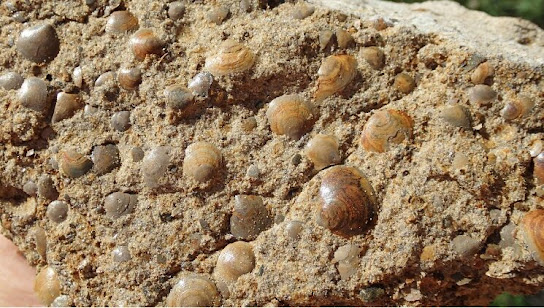''' '' ECOLOGY -PHOSPHORUS-
EVOLVES '' '''
THE PRIZE IN A BATTLE FOR SUPREMACY
IN ANCIENT OCEANS. On a very different Earth, long ago, phosphorous was an evolutionary treasure.
IN THE CAMBRIAN PERIOD - 500 MILLION YEARS AGO, the armored set ruled the seas. Soft-bodied animals secreted a mineral paste that hardened into protective shells of immense strength and deco beauty, some shaped like rams' heads or eagles' wings others like champagne flutes studded with dagger-sharp spines.
But by the Devonian Period some 70 million years later, most of these brachiopods, bripods and their relations had gone extinct, victims of theft and their own extravagance.
As researchers recently proposed in the journal Trends in Ecology and Evolution, the collapse of the brachiopod empire exemplifies a struggle that has defined life from the start : the quest for phosphorous.
Scientists have long known that the element phosphorous is essential on many fronts, here holding the DNA molecule together, there powering the cell's every move.
The new report emphasizes yet another way that phosphate, the biochemically useful form of phosphorous, has shaped the course evolution as an arbiter of nature's hard parts - its shells and teeth and bones.
''Phosphorous was stolen by the vertebrates, the bony fishes,'' said Petr Kraft, a paleontologist at Charles University in the Czech Republic and an author of the report. ''And once this happened, they diversified quickly and took over.'' Dr. Kraft collaborated with Michal Mergl of the University of West Bohemia.
The research is part of a renaissance of phosphate studies, an enterprise that spans disciplines and time frames. Chemists are exploring how phosphates managed to season the prebiotic broth that gave rise to life in the first place, while materials scientists are manipulating the element into startling new colors and forms.
''If you heat phosphorous under different conditions, different temperatures, different pressures, strange things start to happen,'' Andrea Sella, a professor of inorganic chemistry at University College London, said. ''You get red fibrous forms, metallic black forms, purple forms.''
You can also stack up layers of phosphorous atoms and then pull them apart into ultrathin and flexible sheets called phosphorenes, all with the goal of controlling the flow of electrons and light particles on which technology depends. ''We've only scratched the surface of what elements can do,'' Dr. Sella said.
Phosphorus was discovered in the late 17th century by a Hamburg alchemist, Hennig Brand, who inadvertently isolated it while seeking the storied ''philosophers' stone'' that would transform ordinary metals into gold.
Experimenting with large quantities of the golden liquid he knew best - human urine - Brand emerged with an eerie substance that lacked any Midas touch but did grow in the dark, prompting Brand to christen in phosphorus, Greek for ''bringer of light.''
This pure form of element, called white phosphorus, turned out to be toxic and flammable and has been used in warfare - to make tracer bullets, smoke screens and the Allied firebombs that destroyed Brand's hometown during World War II.
White phosphorus also won grim Dickensian fame in the 19th century, when it was added to the tips of matchsticks to produce ''strike anywhere'' matches.
The girls and women who toiled in poorly ventilated factories churning out the enormously popular product were sometimes exposed to so much phosphorous vapor that they contracted ''phossy jaw,'' a horrifying condition in which their gums receded, their teeth fell out and their jawbones dissolved.
According to the historian Louise Raw, matchstick makers' struggle for safer working conditions helped galvanize the modern trade union movement.
Pure phosphorus does not exist in nature, but instead is bound up with oxygen, as phosphate, and this molecular trade union, the phosphorus-oxygen bond ''is central to my biology works,'' said Matthew Powner, an organic chemist at University College London.
The body stores and burns energy by perpetually making and breaking the phosphate bonds found in the cell's little cash machines, its adenosine triphosphate molecules, better known as ATP.
The phosphate recycling operation is so relentless, Dr. Powner said, ''you basically turn over your body weight in ATP every day.''
Phosphate conjoins with sugar to form the backbone of DNA, holding in meaningful order the letters of genetic information that would otherwise collapse into alphabet soup.
The Honour and Serving of the Latest Global Operational Research on Evolutionary Treasures, continues. The World Students Society thanks author Natalie Angier.
With respectful dedication to Research Scientists, and then Students, Professors and Teachers of the World. See Ya all prepare and register for Great Global Elections on The World Students Society - the exclusive ownership of every student : wssciw.blogspot.com and Twitter - !E-WOW! - The Ecosystem 2011 :
Good Night and God Bless
SAM Daily Times - the Voice of the Voiceless

.png)


0 comments:
Post a Comment
Grace A Comment!